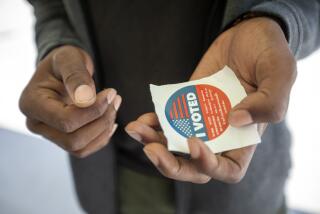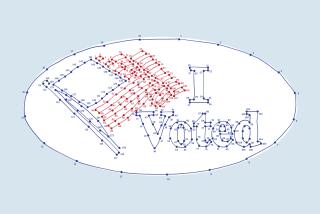It’s Back to a Closed Primary for Most Voters
- Share via
California voters casting ballots in the March 5 elections are going to find they have far fewer choices than they did under the state’s short-lived “blanket” primary system.
No longer will everyone, regardless of party affiliation, get the same long ballot listing every candidate in every party, as they did in the 1998 and 2000 primaries.
Once again, Democrats will get ballots listing only Democratic candidates, Republicans only Republicans and so on.
But there is an important, potentially far-reaching feature in the new system that gives independent, or “decline to state,” voters wider latitude than those affiliated with a political party.
Once barred from any partisan primary, independents now can pick a ballot that lists only propositions and nonpartisan contests--or they can choose a partisan ballot of one of four parties, including Republican and Democratic.
Tuesday is the deadline to register to vote or to switch affiliation in a primary system whose rules have become about as constant as sand on a wind-swept beach.
“I am very concerned that confusing new state election laws will result in unintended consequences, including much greater opportunity for misunderstandings and errors on the part of voters and precinct poll workers alike,” said Conny McCormack, Los Angeles County registrar, in announcing a campaign to improve voter awareness of the latest set of rules and other changes likely to produce confusion.
(Among them is a change that allows voters to register up to 15 days before an election, instead of closing the rolls at 29 days.)
Voters shook things up in 1996 by overwhelmingly passing Proposition 198, a state ballot initiative that threw out the “closed primary” system that had been in effect for nearly four decades.
Under that system, only those affiliated with a political party could help choose that party’s nominees; independents were limited to voting on ballot measures and in nonpartisan races.
Backers of Proposition 198 predicted that an open primary system would improve voter interest and produce more centrist candidates for the general elections in November.
Critics dubbed it the “free love primary” because it allowed voters, including independents, to skip all over the single, all-inclusive ballot with no fidelity to party identification, choosing a Democrat for one office, a Republican for the next, and perhaps a third party candidate for the next.
Leaders of the state’s Republican and Democratic parties, along with two minor parties, teamed up to file suit, arguing that the open primary corrupted their nominating processes. Parties should have the right to have their nominees chosen only by those who share their political views enough to affiliate with them, they argued.
Two lower courts refused to overturn the blanket primary, but in June 2000, the U.S. Supreme Court ruled that such a system violates the political parties’ constitutional right of free association.
So, for now at least, it’s back to the closed primary--with one important exception. Lawmakers determined to salvage at least part of the open system passed legislation allowing independents to vote in a party primary, so long as the party agrees to permit such voters to help nominate its candidates.
The Republican and Democratic parties, along with two so-called minor parties--the American Independent and Natural Law--all notified the secretary of state that they would permit unaffiliated voters to choose one of their ballots. Three other minor parties--Green, Libertarian and Reform--will not.
To distinguish the current system from its predecessors, elections officials have labeled it the “modified closed primary.” McCormack quipped that she and other registrars prefer to think of it as the “slightly ajar primary.”
Political scientists say it will take an election cycle or two to see how the semi-closed system will affect the political process.
Most expect there will be an increase in independent voters as people realize they have greater flexibility in choosing candidates than if they affiliated with a political party.
They probably will also be increasingly targeted by campaign strategists, especially by centrist campaigns in tight primaries, where independents could make the difference, said UC Berkeley political scientist Bruce Cain.
Cain analyzes California’s experience with the blanket primary in his book “Voting at the Political Fault Line,” to be published this spring.
“We’ve learned from our blanket primary experience that independents tend to go where the action is--if there is a tight race on one side and not on the other, they will go vote in the tight race,” Cain said. He found they also tend to vote for popular incumbents and for moderates.
Cultivating independent voters and encouraging them to vote in a partisan primary “is a real opportunity for moderate candidates,” Cain said.
More to Read
Get the L.A. Times Politics newsletter
Deeply reported insights into legislation, politics and policy from Sacramento, Washington and beyond. In your inbox three times per week.
You may occasionally receive promotional content from the Los Angeles Times.











